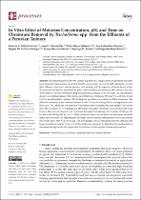| dc.contributor.author | Tello-Galarreta, Fabricio A. | |
| dc.contributor.author | Durand-Paz, Juan H. | |
| dc.contributor.author | Rojas-Villacorta, Walter | |
| dc.contributor.author | Cabanillas-Chirinos, Luis | |
| dc.contributor.author | De La Cruz-Noriega, Magaly | |
| dc.contributor.author | Nazario-Naveda, Renny | |
| dc.contributor.author | Benites, Santiago M. | |
| dc.contributor.author | Rojas-Flores, Segundo | |
| dc.date.accessioned | 2023-11-02T15:28:35Z | |
| dc.date.available | 2023-11-02T15:28:35Z | |
| dc.date.issued | 2023-05-11 | |
| dc.identifier.uri | https://hdl.handle.net/20.500.13067/2744 | |
| dc.description.abstract | The effluents generated by the tannery industry have a high content of chromium and other toxic elements, representing a potential threat to ecosystems. An eco-friendly alternative to treat these effluents is the use of microorganisms, such as fungi, with the capacity to biosorb heavy metals. The present work aims to determine the effect of the molasses concentration, pH variation, and time on the removal of total chromium using the filamentous fungus Trichoderma spp. An experimental design was adopted using pH (4 and 6), concentrations of molasses (0.5 and 1%), and time (8 and 12 days) as independent variables. The Trichoderma inoculum was constant in all the treatments. The different treatments were evaluated after 0, 8, and 12 days by taking 50 mL of sample from each bioreactor. The chromium concentration was subsequently determined in each sample. The results show that treatment 3 (1% molasses and pH 4) showed higher chromium removal after both 8 and 12 days. The concentrations of total chromium decreased from 665 mg/mL to values of 568 mg/mL by day 8 and 486 mg/mL by day 12. These values are, however, still above the maximum threshold imposed by Peruvian law regarding the discharge of non-domestic effluents into the sewage system. The results show that Trichoderma spp. can increasingly remove chromium from the effluent with longer incubation periods. However, future studies are necessary to determine the mechanisms of chromium biosorption by the fungus and the influence of other physicochemical parameters. | es_PE |
| dc.format | application/pdf | es_PE |
| dc.language.iso | eng | es_PE |
| dc.publisher | MDPI | es_PE |
| dc.rights | info:eu-repo/semantics/openAccess | es_PE |
| dc.rights.uri | https://creativecommons.org/licenses/by/4.0/ | es_PE |
| dc.subject | Trichoderma | es_PE |
| dc.subject | pH | es_PE |
| dc.subject | Molasses | es_PE |
| dc.subject | Chromium removal | es_PE |
| dc.subject | Tannery effluents | es_PE |
| dc.title | In Vitro Effect of Molasses Concentration, pH, and Time on Chromium Removal by Trichoderma spp. from the Effluents of a Peruvian Tannery | es_PE |
| dc.type | info:eu-repo/semantics/article | es_PE |
| dc.identifier.journal | Processes | es_PE |
| dc.identifier.doi | https://doi.org/10.3390/pr11051557 | |
| dc.subject.ocde | https://purl.org/pe-repo/ocde/ford#2.07.00 | es_PE |
| dc.source.volume | 11 | es_PE |
| dc.source.issue | 2023 | es_PE |
| dc.source.beginpage | 1 | es_PE |
| dc.source.endpage | 11 | es_PE |


